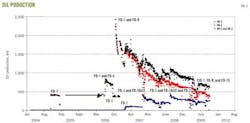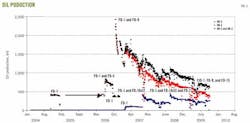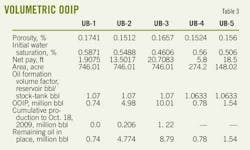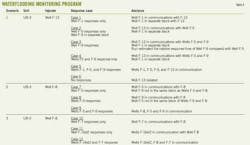Approach assesses waterflooding benefits in Egyptian oil field
View Article as Single page
Wells F-1, F-5, and F-7 have commingled production. Therefore, the analysis had to allocate the production data to each producing zones.
Fig. 3 shows the production history for UB-2 and UB-3. The cumulative production from UB-2 and UB-3 to Oct. 18, 2009, was 206,084 bbl and 1,215,525 bbl, respectively.
OOIP estimate
The estimated OOIP in the Upper Bahariya formation was based on both volumetric and material-balance calculations. Table 3 shows the volumetric estimate for the five units.
Four material-balance runs estimated the OOIP. Run 1 included UB-2 producing wells Wells F-1, F-7 and F-16ST2.
Two cases for Run 1 used the production and the pressure data of UB-2 with and without aquifer support. The two cases had the same analytical match when the two curves were superimposed, indicating no aquifer support.
Estimated OOIP from this run was 5 million bbl, which was nearly the same as the volumetric estimate, indicating that UB-2 might be a homogeneous single zone.
Run 2 on UB-3 wells F-1, F-5, F-9, and F-15 assumed all wells were in the same block. Run two also had two cases: with and without aquifer support. Because the cases did not match, the static model assumed Well F-1 was in a separate block in Runs 3 and 4.
Run 3 included only Well F-1 in UB-3, again with two cases of with or without aquifer support. Only the case with aquifer support matched the production and pressure to give an OOIP of 3.9 million bbl.
Run 4 included Wells F-5, F-9, and F-15 in UB-3, with and without aquifer support. The two cases had matching performance when superimposed. Estimated OOIP was 8 million bbl compared with the volumetric estimate of 10 million bbl.
The material balance of the two blocks (Runs 3 and 4) resulted in an estimated 11.9 million bbl of OOIP.
Waterflooding program
A waterflooding program with three different scenarios and 12 cases investigated the uncertainties of the static model (Table 4).
The design criteria of the waterflooding program took into account the following considerations:
• The unit with a higher remaining oil in place has the priority for waterflooding. Candidates for a waterflooding pilot were UB-3 and UB-2.
• Analysis of the relative well locations with respect to reservoir dip, the existing perforated intervals, and the current production of the wells determined which wells should be converted to injectors. The injectors were Wells F-8 and F-13 in UB-3 and Well F-8 in UB-2.
Displaying 3/4
View Article as Single page



